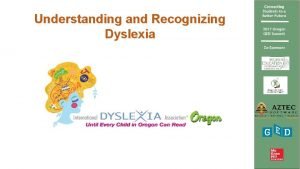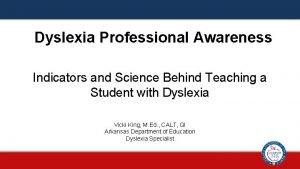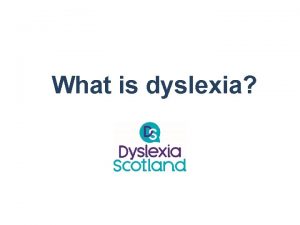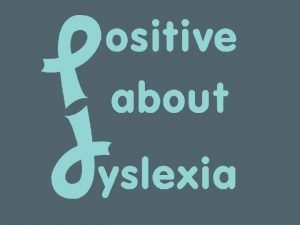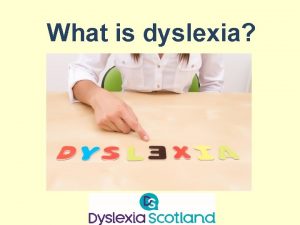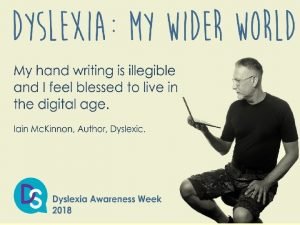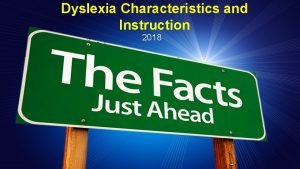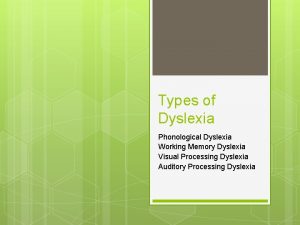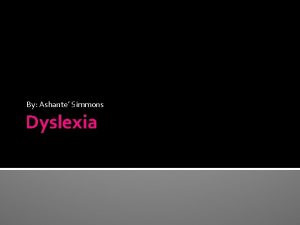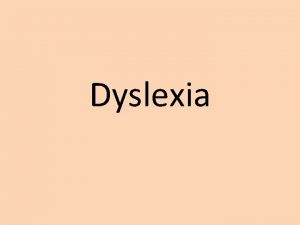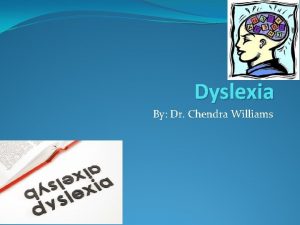Dyslexia Definition of Dyslexia Dyslexia is a specific







- Slides: 7

Dyslexia

Definition of Dyslexia • Dyslexia is a specific, neurological learning disability. • It is characterized by difficulties and/or fluent word recognition, and by poor spelling and decoding abilities. • These difficulties typically result from a deficit in the phonological component of language that is unexpected in relation to other cognitive abilities and the provision of effective classroom instruction Source: International Dyslexia Association

Source: Overcoming Dyslexia: A New and Complete Science Based Program for Reading Problems at Any Level by Sally Shaywitz, M. D.

Fact or Fiction? myth fact Dyslexics see words backwards Dyslexics have problems sequencing the sounds in a word Vision therapy, colored lenses can correct dyslexia Dyslexia is a phonologically based problem Children outgrow dyslexia Dyslexia is not outgrown, but with appropriate interventions and accommodations, they can be taught to read fluently and spell accurately. Dyslexia affects mostly boys Dyslexia affects comparable numbers of boys and girls Source: http: //dyslexia. yale. edu/Myths. html

Signs of Dyslexia Preschool K/1 • Trouble learning nursery rhymes 2 nd+ • Failure to recognize that • Fracturing words (ex: words come apart into flustrated-frustrated) units • Difficulty remembering • Often pauses hesitates, the names of the letters • Inability to connect the and or uses lots of letters with sound “umms” when speaking • Failure to learn the letters in their own • Inability to read • Difficulty with spelling name common, one syllable and order of letters words and/or numbers • Persistent baby talk • Reading errors that • Does not read fluently show no connection to the letter sounds Signs of Dyslexia Sources: 1)Yale Center for Dyslexia and Creativity 2)Elaine Offstein www. seeyourbrainwaves. com

Best Practices 1)Orton-Gillingham based tutoring – multisensory, sequential, systematic review 2)Accomodations Sources: 1) International Dyslexia Association 2)Yale Center for Dyslexia and Creativity

Good Sources: 1)Target the problem http: //www. readingrockets. org/oldmedia/target_handout. pdf Great overview of the eight common reading problems students face. It presents each problem from the student, teacher, and parent perspective and what can be done to help 2)The Yale Center for Dyslexia and Creativity http: //dyslexia. yale. edu/%3 Fgclid=CISy 6 a. KEk 70 CFY 0 -Mgod. Pz. MAug This Center was founded by Drs. Sally and Bennett Shaywitz who are both physicians and researchers. They have studied dyslexia for over 20 years. 3)Orton Gillingham http: //www. orton-gillingham. us An approach to reading instruction developed in the mid-1930 s by Samual Orton, a neuropsychiatrist and researcher, and Anna Gillingham, a professor and psychologist, both form Columbia University Their approach is language-based, structured, multi-sensory, and sequential. OG is the basis or many current reading approaches: Wilson Reading, SIPPS, Herman Method, Barton, Lindamood Bell. 4)International Dyslexia Association http: //www. interdys. org 5)Embracing Dyslexia http: //www. youtube. com/watch%3 Fv=c. BIK 0 XVPb. Xo Documentary on dyslexia


